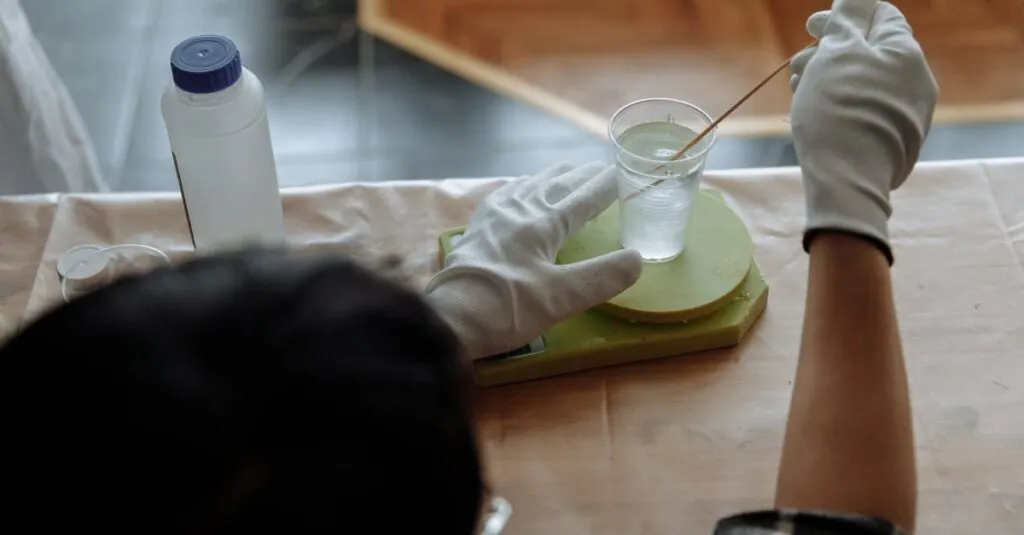Table of Contents
ToggleResin printing can feel like a magical experience, transforming liquid into stunning 3D creations. But when those beautiful prints crack, it’s like watching a magician pull a rabbit out of a hat—only to find it’s a rubber chicken instead. Cracks can ruin hours of hard work and leave even the most seasoned printer scratching their heads in frustration.
Overview of Resin Print Cracking
Resin printing offers an innovative method for creating intricate 3D models. Numerous factors lead to cracking in finished resin prints, such as environmental conditions and material quality. High humidity levels often affect the curing process, leading to weakened structures. Likewise, insufficient exposure during printing can leave the models vulnerable.
Contamination also plays a crucial role in cracks. Dust particles or oil residues may interfere with resin adhesion, resulting in compromised durability. Using clean surfaces and materials reduces the chances of such issues. Moreover, improper post-curing techniques can further exacerbate cracking. A controlled curing environment ensures thorough resin hardening, minimizing potential weaknesses.
Temperature fluctuation contributes significantly to cracking risks. Rapid changes in temperature can create stress within the resin, leading to fractures. Here, maintaining stable temperatures during printing and curing processes proves essential. Adjusting the print settings, such as layer exposure time and print speed, can optimize durability.
Investing in high-quality resin yields better results as well. Cheap resins often have lower tensile strength, making them more susceptible to cracking. Selecting resins specifically designed for durability improves overall print quality. Finally, understanding the printer’s calibration ensures accurate layer heights and proper adhesion, enhancing a model’s resilience against cracking.
Effective crack prevention requires a combination of strategies tailored to specific printing circumstances. Taking all these factors into consideration allows for the successful creation of robust and durable resin prints.
Common Causes of Resin Print Cracking
Resin prints can crack due to several factors. Understanding these causes helps in preventing future issues.
Temperature Fluctuations
Temperature fluctuations can significantly impact resin prints. Rapid changes in temperature create stress within the resin, leading to cracks. For example, moving a print from a warm room to a cold area can cause uneven contraction. Maintaining a stable environment helps minimize these risks. It’s essential to store resin printers and materials in controlled temperatures to avoid such problems.
Improper Curing
Improper curing is a common cause of cracking. Insufficient exposure to UV light during the curing process can weaken the structure of the print. Cracks may emerge if the curing time is too short. Conversely, over-curing can also lead to brittleness. Following manufacturer recommendations for curing times and methods ensures optimal results. Utilizing a dedicated UV curing station can improve consistency.
Material Quality
Material quality plays a crucial role in print durability. Low-quality resin may lack the necessary strength, resulting in cracks during handling. Additionally, expired or improperly stored resin can also compromise the final product. Choosing high-quality resin from reputable suppliers provides better assurance against cracking. Users should regularly check material expiration dates for consistent performance.
Effective Resin Print Cracking Solutions
Users encountering cracking in resin prints can adopt several effective strategies to enhance durability and improve outcomes. Implementing the right techniques during printing can significantly reduce the risk of cracks.
Optimizing Print Settings
Adjusting print settings serves as a primary method for addressing resin print cracking. Users can fine-tune exposure times, increasing the duration for each layer if cracks frequently occur. Slower print speeds may also contribute to improved layer adhesion, which reduces the likelihood of stress fractures. Additionally, experimenting with different layer heights allows for optimal balance between detail and strength. High-quality slicing software helps identify ideal configurations tailored for specific resins, ensuring the best results for each print.
Using Support Structures
Support structures play a crucial role in minimizing strain on prints. Adequate supports provide needed stability during the printing process and lessen the chance of deformation that leads to cracking. Users should strategically place supports to maintain structural integrity while also minimizing their visual impact. Various support options exist, allowing for customization based on print type and geometry. They should ensure proper removal techniques that won’t damage the final product, as careful management during this phase prevents unnecessary stress on the print.
Post-Processing Techniques
Incorporating effective post-processing techniques can further mitigate cracking. Proper curing is vital; users must follow recommended UV exposure times for their specific resin to prevent over-curing, which can make the print brittle. Washing prints thoroughly in an appropriate solution also removes uncured resin, ensuring a durable final product. Additionally, users can apply clear coats or additional resins specifically designed to enhance surface strength. These post-processing steps improve the overall resilience of prints on top of enhancing their visual appeal.
Prevention Strategies for Resin Print Cracking
Cracks in resin prints can often be prevented by implementing specific strategies. Taking the right steps can make a significant difference in final results.
Choosing the Right Resin
Selecting high-quality resin plays a critical role in ensuring the durability of prints. Premium resins typically exhibit better adhesion and chemical resistance. Users should consider specialty resins designed for specific needs, such as flexible or tough formulations. Checking the expiration date ensures freshness and optimal performance. In addition, utilizing resins from reputable manufacturers can further minimize cracking issues. Matching the resin type to the printer’s specifications is essential for successful results.
Environmental Controls
Maintaining a stable environment is vital for preventing cracks in resin prints. Humidity levels should remain between 40% and 60% to minimize the impact on adhesion. A consistent temperature, ideally around 20°C to 25°C, reduces stress during printing. Using air purifiers helps remove contaminants, ensuring a clean workspace. Print chambers equipped with heaters can stabilize conditions, especially during colder seasons. Furthermore, controlling UV exposure during both printing and curing phases enhances the integrity of the prints. Adopting these environmental controls can significantly improve print quality and longevity.
Conclusion
Addressing resin print cracking is essential for achieving high-quality 3D prints. By understanding the factors that contribute to cracking and implementing effective strategies, users can significantly enhance the durability of their creations. Optimizing print settings and using quality materials play a crucial role in mitigating risks.
Maintaining a stable environment and employing proper post-processing techniques further bolster resilience. With a proactive approach to preventing cracking, users can enjoy the full potential of resin printing and create stunning, long-lasting pieces. Embracing these best practices ensures a more satisfying printing experience and elevates the quality of finished products.




